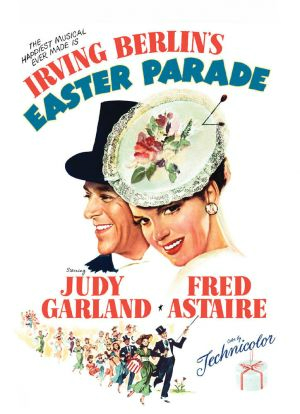Anne Marie is tracking Judy Garland's career through musical numbers...
 Easter Parade has becomea perrenial holiday favorite. Inevitably, the lighthearted musical appears on TCM Easter Sunday marathons, sandwiched between Ben Hur (1959) and King of Kings (1961). However, despite the annual dominance of this Judy Garland/Irving Berlin musical, the movie nearly stopped before it began. A combination of bad luck, souring relationships, and weak ankles nearly prevented the production from getting off the ground. Fans of the film have one person to thank for its resurrection: Fred Astaire.
Easter Parade has becomea perrenial holiday favorite. Inevitably, the lighthearted musical appears on TCM Easter Sunday marathons, sandwiched between Ben Hur (1959) and King of Kings (1961). However, despite the annual dominance of this Judy Garland/Irving Berlin musical, the movie nearly stopped before it began. A combination of bad luck, souring relationships, and weak ankles nearly prevented the production from getting off the ground. Fans of the film have one person to thank for its resurrection: Fred Astaire.
The Movie: Easter Parade (1948)
The Songwriter: Irving Berlin (music & lyrics)
The Players: Judy Garland, Fred Astaire, Ann Miller, Peter Lawford, directed by Charles Walters
The Story: The production of Easter Parade was plagued from the start. Though Irving Berlin enthusiastically agreed to expand upon his hit Holiday Inn for a new Judy Garland vehicle, the rest of the cast and crew was harder to secure. Originally, MGM sought to replicate the Freed unit partnerships that had already been proven box office success: Judy Garland and Gene Kelly, directed by Vincente Minnelli. But Judy and Minnelli were fighting, so she demanded that he be replaced with Charles Walters, a choreographer-turned-director on his second feature film. Then, Kelly broke his ankle playing football. Then Cyd Charisse broke her ankle. With two of three stars out of commission and a neophyte director at the helm, Easter Parade needed a big win. Then out of retirement waltzed Fred Astaire.
While the replacement of Gene Kelly with Fred Astaire saved the film, it also provides a window into how well-tailored numbers were tailored to their musical stars. Though "I Love A Piano" starts with the now old familiar standby of Judy Garland standing by a piano and singing to her beaux, it also moves into the high-energy, bright dancing style of Gene Kelly. Adapted to Fred Astaire, this dancing style loses none of its energy, but shows hints of ballroom influence in the lifts and mirrored taps of two partners arm in arm. Astaire doesn't simply stand in for Kelly; he makes the film his own. As a result, Astaire's retirement would turn out to be temporary; he kept on dancing for another 20 years.